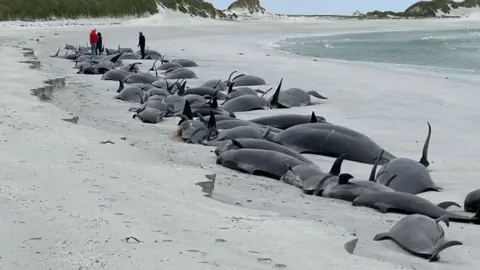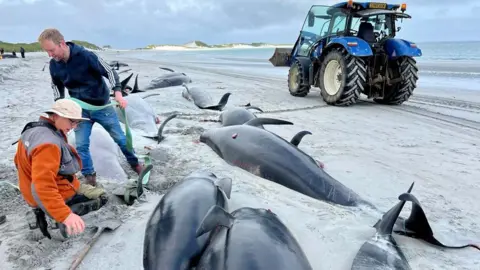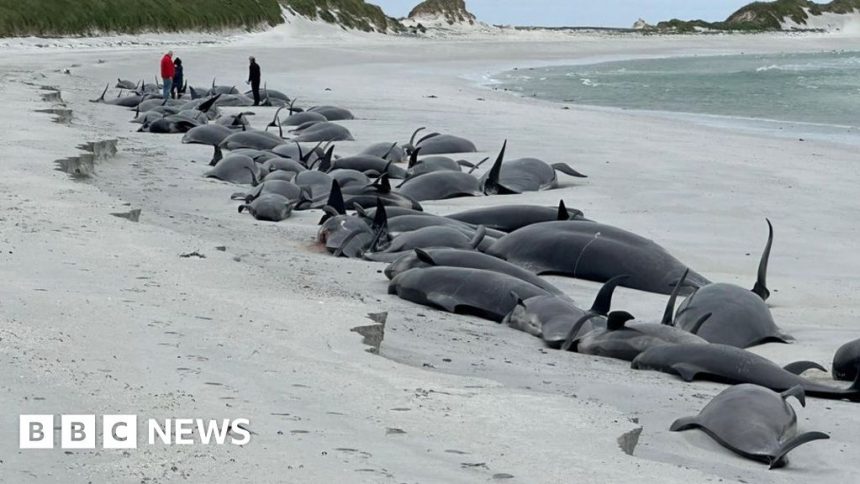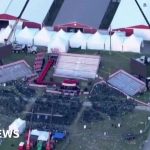Whales were healthy before Orkney stranding – expert
 BBC
BBCA pod of 77 pilot whales that died after washing ashore in Orkney were healthy before they became stranded, according to initial findings.
The animals were found on the island of Sanday on Thursday following what could be the largest mass stranding in nearly 100 years.
Cetacean specialists – whose expertise is in aquatic mammals – have been examining tissue samples to establish the cause of the stranding.
Mariel ten Doeschate, from the Scottish Marine Animal Stranding Scheme, told BBC Scotland News that thorough post-mortems had so far been carried out on about 30 whales.
She said: “Just about everyone in the UK who is involved with whale strandings is here on Sanday.
“We’ve been taking samples to determine the health status of the whales before the stranding and according to our initial preliminary findings, they all seem to have been healthy.
“So it’s unlikely there was a sick leader who they were trying to stay with and protect.”
Members of the public are being asked to stay away from the area.
Experts arrived on the island on Friday and it is thought the full investigation could take three or four days.
“We are working through a process of elimination to find the cause,” said Ms ten Doeschate.
“But these strandings are rarely the cause of a single source, it’s usually a combination of factors.
“Some of the whales had fresh stomach content which suggests they were feeding nearby around the time they became stranded.
“The beach they were stranded on is a very sandy beach which is often difficult for the whales to detect due to how their acoustics work.”
‘Pushed or pulled’
Pilot whales are social creatures and live in a matriarch-style social structure, with the oldest female seen as having the authority in the pod.
Ms ten Doeschate said the animals were stranded close together which is a behavioural stress response and means that something could have frightened them – like a sound or a predator – and made them cluster.
The investigators have taken ear samples from six key whales to look for acoustic trauma.
The research associate said the investigation was a way of ensuring the whales had “not died in vain” as the findings could be used to help wild whales in the future.
She said the team was also investigating if there were any killer whales nearby at the time.
“We need to consider whether they were pulled into going near the land because they were maybe pursuing prey, or were they pushed because they were avoiding something?” she added.

The pod included male whales, measuring up to seven metres (22ft) long, as well as females, calves and juveniles.
The British Divers Marine Life Rescue (BDMLR) established that 12 of the animals at Tresness Beach on the island of Sanday were still alive when they came out of the water.
Emma Neave-Webb, from the BDMLR charity, said the animals were thought have been stranded “for quite some time”.
She said animals were very closely packed together with alive animals next to dead animals.
The area was cut off by the high tide and the whales needed to be moved back into an upright position as quickly as possible if there was to be any chance of saving them.
But the soft sand meant the whales fell back over when the rescuers attempted to right them.
The decision was made to euthanise the animals after efforts to save them failed.
Ms Neave-Webb said that removing the whales was a “massive undertaking”.
Orkney Islands Council confirmed discussions were taking place with community representatives on how best to dispose of the bodies, with the “likely option” being burial.
The stranding is thought to be the largest UK stranding since 1927 when 126 out of more than 130 false killer whales died in the Dornoch Firth, in the Highlands.
Last year an entire pod of 55 pilot whales died following a stranding on Lewis.






